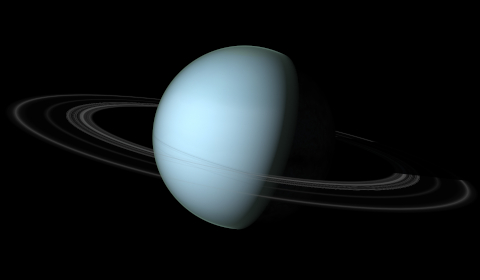- Series:Astronomy, Transcript English
Psalm 19:1
“The heavens declare the glory of God; and the firmament sheweth his handywork.”
 When I learned about planets as a boy, Saturn was unique because it had rings. Then, in 1977, we were astonished to discover that Uranus also had rings. Nowadays, we assume that rings are a feature of gas giants; the rings of Jupiter were discovered in 1979 and those of Neptune in 1984.
When I learned about planets as a boy, Saturn was unique because it had rings. Then, in 1977, we were astonished to discover that Uranus also had rings. Nowadays, we assume that rings are a feature of gas giants; the rings of Jupiter were discovered in 1979 and those of Neptune in 1984.
Uranus has an unusual rotation, with its rotational axis very nearly in the same plane as its orbit, whereas, for most planets, the rotational axis is closer to being perpendicular to the orbit. Many photographs of Uranus, therefore, show the rings as near circles around the planet instead of tilted slightly from edge on.
Recent studies have presented astronomers with a mystery. Other planetary rings contain a range of particle sizes, from dust particles to large rocks. However, in the case of Uranus’s most prominent ring – the epsilon ring – the smallest particle size appears to be that of a golf ball. Big Bang astronomers are now puzzling out a mechanism for how the smaller particles could have been removed from the epsilon ring because they cannot accept that one planet’s ring could have formed in a manner different from that of the other planets’ rings.
While it is certainly possible that something removed dust particles from the epsilon ring, it is equally possible that God made this ring to be unique because: “The heavens declare the glory of God, and the sky above proclaims his handiwork.”
Prayer: One again, Lord, we marvel at Your handiwork, proclaimed in what we see in the heavens. Amen.
Author: Paul F. Taylor
Ref: University of California – Berkeley. “Astronomers see ‘warm’ glow of Uranus’s rings: First heat images of the rings enable scientists to determine their temperature.” ScienceDaily, 20 June 2019. <www.sciencedaily.com/releases/2019/06/190620153544.htm>. Image: Adobe Stock Images, licensed to author.
© 2020 Creation Moments. All rights reserved.
